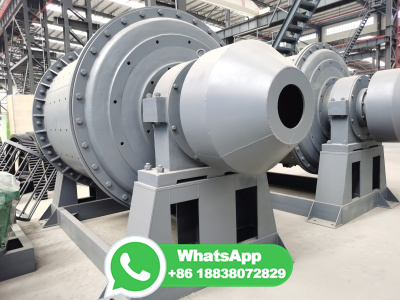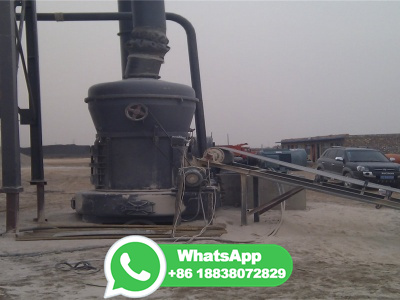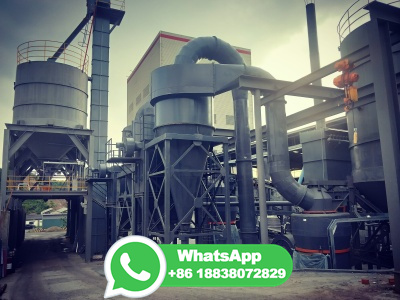
Energy optimization of a circuit has been subject of many of the studies. Jankovic et al. [12] considered the optimization alternatives of cement grinding circuits. Benzer [13] studied on optimizing the fully airswept raw mill grinding circuit, Dundar et al. [14] reported the optimization opportunities of a cement grinding circuit.
WhatsApp: +86 18037808511
A cement mill (or finish mill in North American usage [1]) is the equipment used to grind the hard, nodular clinker from the cement kiln into the fine grey powder that is cement. Most cement is currently ground in ball mills and also vertical roller mills which are more effective than ball mills. History
WhatsApp: +86 18037808511
The finish mill system in cement manufacturing is the second to last major stage in the process, where the feed material is reduced in size from as large as several centimeters in...
WhatsApp: +86 18037808511
Cement is a crucial building material used in construction. The Cement manufacturing process involves the extraction and preparation of raw materials, such as Limestone, clay, shale, iron ore, and Gypsum. These materials are crushed, ground, and blended to form a raw meal, which is then heated in a kiln at high temperatures.
WhatsApp: +86 18037808511
The cement manufacturing process, specifically the kiln and possibly finish mill conditions, can influence how much Cr (VI) will form. POTENTIAL SOURCES OF CHROMIUM. The amounts of total chromium and soluble hexavalent chromium found in clinker and in hydraulic cements may originate from a variety of sources, as exemplified in this section.
WhatsApp: +86 18037808511
Cement manufacturing process. The manufacturing processes of cement may vary with respect to equipment design, method of operation, and fuel consumption. ... Raw material preparation and finish grinding are electricityintensive production steps. Energy consumption by the cement industry is estimated at 6 to 7 EJ or 2% of global primary ...
WhatsApp: +86 18037808511
Raw Materials of Cement. Most important raw materials (what is cement made of) required in the manufacture of Portland Cement are: Limestone, Clay, Gypsum, Fuel, and Water (in wet method). 1. Limestones: These are sedimentary, calcium carbonate rocks (CaC0 3 ). Most commonly they contain a small amount of magnesium carbonate also.
WhatsApp: +86 18037808511
The cement manufacturing process mainly includes four steps: resource extraction, raw material preparation, clinker calcination, cement grinding 17,18, and fossil fuel burning 19.
WhatsApp: +86 18037808511
We have worked with the Cement Manufacturing Industry for decades and offer a portfolio of products to address your challenges in every stage of the production process, from raw materials sourcing to milling and kiln operations, through energy management, finished product quality and, of course, with worker and environmental safety in mind.
WhatsApp: +86 18037808511
Portland Cement Plant 4 Preparatory and Inspection Guide 2/82 Inspection Procedures. equipment information (described in later sections) also should be obtained at this time and recorded as seen in Figures 2 and 3. These checklists can be duplicated and used to obtain in formation during the inspection.
WhatsApp: +86 18037808511
Step 1: Mining. The cement manufacturing process starts from the mining of raw materials that are used in cement manufacturing, mainly limestone and clays. A limestone quarry is inside the plant area and a clays quarry is as far from the plant area as 25 km. The limestone is excavated from open cast mines after drilling and blasting and loaded ...
WhatsApp: +86 18037808511
In terms of manufacturing processes, 34 out of 48 sites carried out the complete cement production cycle, while 14 plants performed only the third stage of the manufacturing process (Figure 1, finish grinding process). Moreover, the finished products manufactured by the production sites were those shown in Table 1. The variety of production ...
WhatsApp: +86 18037808511
Cement is so fine that 1 pound of cement contains 150 billion grains. The cement is now ready for transport to readymix concrete companies to be used in a variety of construction projects. Although the dry process is the most modern and popular way to manufacture cement, some kilns in the United States use a wet process.
WhatsApp: +86 18037808511
The cement manufacturing Process can be broadly classified into following activities Raw Material Acquisition Most of the raw materials used are extracted from the earth through mining and quarrying and can be divided into the following groups: lime (calcareous), silica (siliceous), alumina (argillaceous), and iron (feurriferous).
WhatsApp: +86 18037808511
cement ball mill. Application: limestone, clay, coal, feldspar, calcite, talc, iron ore, copper, phosphate, graphite, quartz, slag. Capacity: .65615T/H. The cement ball mill usually can be applied to raw meal grinding or cement grinding. Besides, the cement ball mill also can be used for metallurgical, chemical, electric power, other mining ...
WhatsApp: +86 18037808511
There are four stages in the manufacture of portland cement: (1) crushing and grinding the raw materials, (2) blending the materials in the correct proportions, (3) burning the prepared mix in a kiln, and (4) grinding the burned product, known as " clinker," together with some 5 percent of gypsum (to control the time of set of the cement).
WhatsApp: +86 18037808511
As stated by Su et al. [7], the cement manufacturing process can be divided into three major stages: raw material processing, clinker production, and finish grinding processing (finished cement production). A schematic representation of the cement production process is illustrated in Figure 1.
WhatsApp: +86 18037808511
Vertical roller mills offer supreme grinding with high energyefficiency. Whether grinding raw coal, clinker, cement and/or slag, we have a VRM solution to suit your grinding needs. What's more, our online condition monitoring services enable you to adopt a proactive maintenance strategy for your OK™ and ATOX® mills that eliminates ...
WhatsApp: +86 18037808511
Table 1. Raw materials are used to produce the main cement elements (Mohsen, 2015) • Quarry The process of obtaining raw materials for cement manufacturing involves mining and quarrying natural ...
WhatsApp: +86 18037808511
Read about "Seattle Aggregate Yard" and other posts from CalPortland. For more information regarding our products please call us at: (626)
WhatsApp: +86 18037808511
Raw material grinding (515 kWh/t of clinker) Coal grinding (24 kWh/t of clinker) Cement grinding (3060 kWh/t of clinker)
WhatsApp: +86 18037808511
energy required for the f inish mill in the cement manufacturing process. finish mill has 5 streams which are divided . into 3 inflows and 2 outflows. The inflow is in the form of feed s tream ...
WhatsApp: +86 18037808511
This is a dry cement manufacturing process, which operates with a nearly dry raw mix containing less than 20% moisture by mass. However, in a wet process water is added to the raw mix to form slurry and then is transported to the kiln. ... Horizontal roller mill for finish grinding found to save highest amount of energy of about 3540% of ...
WhatsApp: +86 18037808511
Because raw coal is still used in cement manufacturing, equipment that can grind coal onsite is necessary for most cement plants. As with the actual milling of cement, manufacturing equipment used to break down the coal requires mechanisms with airlock capabilities. These must be able to handle capacities from 10100 tons hourly.
WhatsApp: +86 18037808511
Step 4:Cement grinding and storage. Clinker and gypsum for Ordinary Portland Cement (OPC) limestone for limestone cement, and slag for slag cement are all extracted from their respective hoppers and fed to the cement mills. The ball mill grinds the feed to a fine powder in two chambers, namely the first and second chambers.
WhatsApp: +86 18037808511
5 Cooling and final grinding. The clinker is then cooled and ground to a fine powder in a tube or ball mill. A ball mill is a rotating drum filled with steel balls of different sizes (depending on the desired fineness of the cement) that crush and grind the clinker. Gypsum is added during the grinding process to provide means for controlling ...
WhatsApp: +86 18037808511
A Simplified Schematic of a Dry Cement Manufacturing Process.[2] ... calculate the finish mill circuit while all other . parameters of the model were kept constant, as sho wn in
WhatsApp: +86 18037808511
The mill proper is 256 feet in length by 56 feet in breadth, with two stories, the upper story for the manufacture of lumber and the lower story occupied by planing machines and a lath mill. The boiler room is a separate building, to the west of the mill, with concrete foundation, corrugated iron sides, and gravel roof.
WhatsApp: +86 18037808511
The Lehigh Cement Company (Lehigh) owned and operated a cementprocessing plant at this site from 1914 until the plant closed in 1989. Cement kiln dust (CKD), a byproduct of cement production, was collected from the plant and disposed of in a landfill on the site. In 1996, Lehigh closed the CKD landfill, which is now known as the closed CKD pile.
WhatsApp: +86 18037808511
1. Introduction. Over the last century, Portland cementbased concrete has become the highest manufactured product on Earth in terms of volume. Concrete is used worldwide as a building material and is the most consumed substance on Earth after water (Sakai, 2009).The volume of concrete produced globally is approximately billion m 3 per year (Roskos et al., 2011), with more than ...
WhatsApp: +86 18037808511
Flexco has spent countless hours working alongside cement customers to understand the realities of your everyday challenges and we have a comprehensive range of belt conveyor products to address your pain points at every step of the cement manufacturing process from the Quarry to the Finish Mill. demand for cement is expected to double by 2025.
WhatsApp: +86 18037808511
Stage of Cement Manufacture. There are six main stages of the cement manufacturing process. Stage 1: Raw Material Extraction/Quarry The raw cement ingredients needed for cement production are limestone (calcium), sand and clay (silicon, aluminum, iron), shale, fly ash, mill scale, and bauxite. The ore rocks are quarried and crushed into smaller pieces of about 6 inches.
WhatsApp: +86 18037808511
Inline kiln/raw mill means a system in a portland cement production process where a dry kiln system is integrated with the raw mill so that all or a portion of the kiln exhaust gases are used to perform the drying operation of the raw mill, with no auxiliary heat source used. In this system the kiln is capable
WhatsApp: +86 18037808511
Cement manufacturing process is a reliable bonding material. It is obtained by burning calcareous material (lime) and argillaceous material (clay) and then grinding, types of cement. The cement manufacturing process was first produced by Joseph Aspidin, a mason from England. As its color resembled a variety of sandstone found in Portland, he named it Portland cement (1842).
WhatsApp: +86 18037808511
The portland cement manufacturing industry is relying increasingly on replacing materials with waste materials or byproducts from other manufacturing operations, to the extent that such replacement can be implemented without adversely affecting plant operations, product quality or the environment.
WhatsApp: +86 18037808511